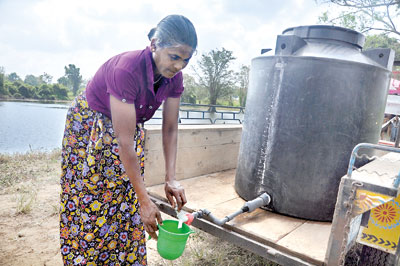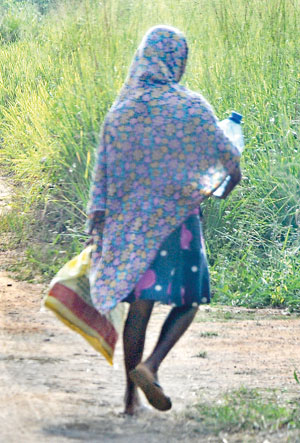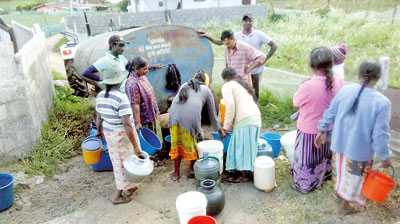News
From north to south, bowsers being sent to parched villages

A villager in Rambawewa in Anuradhapura takes water from a bowser while below another walks away after receiving a bottle of water. Pix by NIlan Maligaspe
Drinking water problems persist in several areas despite rains bringing relief to parts of the country as the intense heat triggers a sharp rise in water consumption.
The main issue faced by the the National Water Supply and Drainage Board (NWSDB) during the past several weeks was seawater spilling into the Kalu and Nilwala rivers as a result of the dry spell, the Chairman of the NWSDB Alahudeen Ansar said.
This meant that parts of the Kalutara and Matara districts faced a severe drinking water problem as the salinity of the river water had increased.
“We have no facilities to treat the water in such a situation and we had to provide drinking water by sending water tanks and bowsers to certain areas,” Mr. Ansar said. After construction of sandbag barriers and several days of heavy rain, however, the situation has now markedly improved, he noted.
In the Southern Province, drinking water problems are still present in all three districts. In parts of the Galle District, the NWSDB supplies water only from evening to early morning. “The schedule is from 5 p.m. to 6 a.m. In certain mountainous areas such as Akmeemana it is difficult to keep to this schedule as there is not enough water pressure to supply to elevated areas. They get water for a shorter time,” Galle District NWSDB Manager I.D. Wijesiri said.
A schedule has also been put in place for water supply to the Matara District, said NWSDB Matara Manager, S.K. Saman Kumara. “In certain rural pockets of the district, water is still being distributed using bowsers. Matara town, meanwhile, is divided into two sections. Water is supplied to each section every other day of the week.”
The situation looks bleakest in Hambantota. District NWSDB Manager R.K.W.K. Ranasingha said all water sources have completely dried up in the Kirama and Katuwana areas.
“Our supply to these areas is very limited and most of the drinking water is currently provided through bowsers. Our distribution line cannot cope with the high demand,” he said.
Mr. Ranasingha also said that the Kattakaduwa tank had almost dried up and water level of the Kirama Oya was also dropping. In response to an appeal by the NWSDB, the Mahaweli Authority has diverted some water to ease the situation.
“That is sufficient for about a week. If water level of the Kirama Oya continues to fall however, we could have a drinking water shortage affecting the Ranna and Hungama areas as well as Tangalle town,” Mr. Ranasingha warned.
In the Central Province, rains have brought some measure of relief. The Nuwara Eliya District had been hit hard due to the drought over the past few months. District Secretary Helen Meegasmulla said the situation has now improved considerably due to rains over the past two weeks, and added she did not expect further water shortages.
Last month, several areas in the central hills, such as Hatton, Maskeliya and Nallathanniya experienced a severe drinking water shortage.
In the Uva Province, Badulla District Secretary Nimal Abeysiri said the district was now experiencing heavy rains and there was no water shortage. The NWSDB’s Deputy General Manager (Uva), M.I.A. Latiff, however, said in certain parts of the province they had been forced to cut down the hours of water supply. “We have asked people to conserve water, and so far they have done so and we have not received any complaints,” he added.
Jaffna District DS N. Vedanayagam said they expected the next two months to offer severe problems in terms of water shortages in the district. Water shortages can be expected in certain areas of the Jaffna peninsula and its outlying islands, such as Kayts. He said the authorities will probably start delivering water to some areas with bowsers from next month.
In the North Central Province, Anuradhapura DS D.P.G. Kumarasiri said there had been no reports of water shortages in the district thus far, though officials were continuously monitoring the situation.

Before the recent rains: Residents of Nuwara Eliya stand in line with bukets to collect water. Pic by Shelton Hettiarachchi
The situation was somewhat different in neighboring Polonnaruwa, where a severe drinking water crisis was affecting the Welikanda area. District Secretary S. Senanayake said heavy rain over the last several days had somewhat eased the situation.
Drinking water shortages have also affected Ratnapura District in the Sabaragamuwa Province. Ratnapura DS Bandula Harischandra said most of the difficulties had been reported from the Eheliyagoda and Embilipitiya areas. “Thankfully, the rains have now started to fall and there is no longer a request for us to supply water to these areas,” he added.
In the East, the NWSDB’s Deputy General Manager U. Ratnapala said they had been able to manage the situation so far. If the situation continues, the board will have to come up with contingency plans to supply water to the public, he observed.
“For example, if the water level in the Kantale tank continues to drop, we can divert water from the Mahaweli River. If the water level in the river drops, we can lay down a sandbag barrier to raise the water level to a point where we can get water. Those options are there and we are prepared to put them into action should the need arise,” Mr. Ratnapala said.
As consumption was high these days it was also difficult to provide water to elevated areas, he further said. In such an event, water will be supplied to these areas through bowsers.
Asked what to expect in the weather during the New Year season and beyond, the Director-General of the Department of Meteorology, Lalith Chandrapala said the inter-monsoonal rains were now being experienced in many parts of the island, particularly in the evenings. Some areas were experiencing rains of around 50mm.
“While we don’t expect an increase in rainfall during the next few days, we expect there to be increased rainfall after April 16,” he said. The south-west monsoon, though, is only expected towards the end of May, he added.

